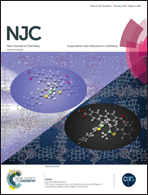Low temperature formation of rectangular PbTe nanocrystals and their thermoelectric properties
Abstract
We report a low-temperature route for the successful generation of rectangular PbTe nanocrystals (NCs) within a short time under continuous heating at 80 °C. The PbTe NCs are formed by the reaction of Te metal powder with Pb-acetate salt in the presence of alkaline 2,7-DHN solution in a CTAB micellar medium. Two different sizes of rectangular PbTe NCs were synthesized just by tuning the CTAB to metal salt precursor molar ratio and controlling other reaction parameters. The optical properties, thermal stability and electronic properties of the PbTe NCs were studied in detail utilizing various instrumental techniques. The growth mechanism for the formation of the rectangular PbTe NCs has been elaborated. Both of the morphologies were tested for their application as thermoelectric (TE) materials. It was observed that both sizes of rectangular PbTe NC could be used as thermoelectric materials and among the two morphologies, the small sized rectangular PbTe NCs showed the maximum TE figure of merit (ZT) value compared to the larger size at 475 K. The high ZT value of the smaller sized rectangular PbTe NCs in comparison to the larger size ones is due to their higher power factor value, as well as their low thermal conductivity value compared to the large sized PbTe NCs. Other than power generation, the synthesized PbTe NCs may be further used in electrochemical biosensors and nano-optoelectronic devices and to improve the light-use efficiency of solar devices.


 Please wait while we load your content...
Please wait while we load your content...